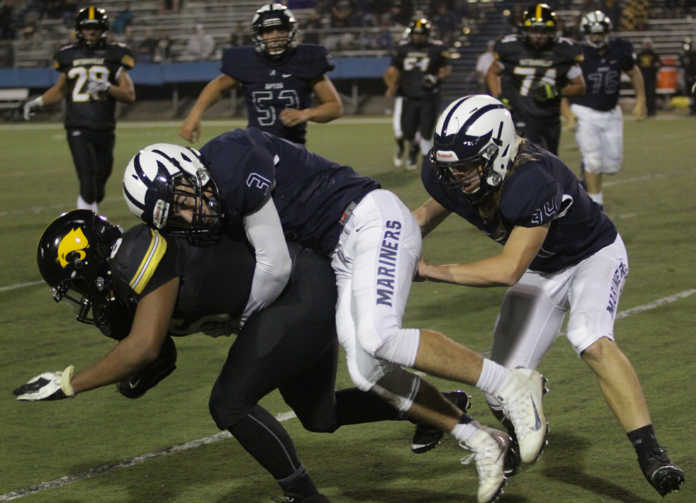WATSONVILLE — More high school students are playing sports than ever in California.
Football and wrestling aren’t having the same luck.
Both sports saw a drastic decline in boy’s student-athlete participation for the second straight year, according to the California Interscholastic Federation’s yearly census, which was released on Tuesday.
The CIF, which is the governing body of high school athletics in the golden state, presented results from a yearly survey of its 1,587 member schools conducted by the National Federation of State High School Associations.
Overall, student-athlete participation was at an all-time high for the fifth consecutive year, making a .78 percent leap to 785,357 participants.
Eleven-player football was still the king of boy’s athletics in terms of numbers, leading all sports with 97,079 participants, but fell by 3.12 percent from last year. It was the first time since 2004-05 that the sport has dipped under the 100,000-mark.
It was also the second consecutive year the sport has seen a sizeable exodus. The year before, 11-player football dropped from 103,725 participants to 100,205.
But it doesn’t mean the sport can’t recover. After dropping to 99,079 participants in 2004-05, the sport exploded back to 107,916 participants two years later. Since then, 11-player football had seen a yearly ebb and flow before the major drop-off in 2015-16.
Interest in football in Santa Cruz County has dropped as of recent. Several programs around the area did not field freshman teams last season and others chose to forgo the junior varsity team, too.
“Looking at our area and how teams are struggling with numbers, those number are not surprising,” said St. Francis High first-year head coach John Ausman. “You’re seeing bigger programs than us that don’t have freshman or JV programs anymore.”
A school of about 250 students, St. Francis struggled generating numbers for football before the start of the 2013 season, forcing the Sharks to bow out of the Santa Cruz Coast Athletic League and play an independent schedule as a varsity-only program.
Since then, the football program has rebounded, adding a frosh/soph team and keeping its numbers above 50.
Yet Ausman said he understood how tough it has become to keep up interest for football, even at a school that had 81 percent of its student body play at least one sport last school year.
Over the years, the state government and the CIF have taken steps to make football safer. In 2015, law AB 2127, which prohibits football teams at the middle and high schools from holding full-contact practices that surpass 90 minutes a day, limits the number of full-contact practices during the season to two per week and prohibits contact practices during the offseason, went into effect and the CIF also put an 18-hour per week cap on high school practices in 2014.
Advances in technology and equipment and new tackling methods have also tried to change the game but results from ongoing studies on concussions have only made it harder to convince parents that football is safe.
Just last week, a report published in the Journal of the American Medical Association found evidence of chronic traumatic encephalopathy (CTE) in 177 of the 202 brains of former football players from varying levels.
In the study, CTE, a degenerative brain disease that can cause of range of symptoms including memory loss, was diagnosed in 110 of 111 brains from former NFL players; 48 of 53 college players; nine of 14 semi-pro players; seven of eight Canadian Football League players; and three of 14 high school players.
The results, however, did not confirm that the condition is common in all football players. It only reflected the high occurrence in donated samples at a Boston brain bank that studies CTE. The samples came from families of players that suffered repeated concussions and showed troubling symptoms before they died.
“I think that concussions are obviously a problem but I also think in order to fully understand them you would have to look at every sport,” Ausman said.
Boy’s wrestling, meanwhile, lost more than 1,000 student-athletes for the third straight season, dropping down to 22,385 participants from 23,969 — the biggest percentage drop (6.61) of any of the top 10 sports. In 2016, boy’s wrestling numbers fell by 2,358 student-athletes and the year before the sport suffered a loss of 1,134 student-athletes.
Boy’s wrestling has fallen off in participation in every year this decade.
Girl’s wrestling, however, continued its annual climb, jumping from 4,105 to 4,505.
THE BEAUTIFUL GAME
Both girl’s and boy’s soccer continued their yearly ascent.
Boy’s soccer jumped from 52,226 student-athletes to 52,795, while girl’s soccer added another 361, totaling 47,139 and remaining the most popular sport among female participants for the second straight year.
Over the last 10 years, girl’s soccer has continued to steadily grow in the CIF. The sport made its biggest leap last year, increasing from 44,809 to 46,778 and overtaking track and field as the top female sport.
Although soccer was still the third most popular sport among boys behind football and track and field, this year’s 1.01 percentage increase was the largest of any of the top five sports. Track and field (.28) and basketball (.91) both saw percentage jumps, while baseball fell (.49).
Basketball was No. 4 among boys with 46,114 participants and baseball was No. 5 with 43,913.
It was the third straight season participation in baseball dropped.
Track and field was No. 2 among girls with 46,276, volleyball saw a 2.54 percent increase and took the No. 3 spot with 44,526, basketball was No. 4 at 34,222 and softball rounded out the top five with 33,265.
Basketball and softball decreased by .48 percent and .30 percent, respectively.
JUMPING, JUMPING
Girl’s lacrosse and 8-player football both saw double-digit percentage jumps.
Girl’s lacrosse grew by 940 student-athletes (12.44 percent) and 8-player football jumped by 196 boys (10.17 percent).
Girl’s wrestling’s 9.47 percent increase was the third biggest jump among all sports.
Boy’s cross country, possibly benefiting from student-athlete departure from football, had the fourth biggest surge, growing 7.42 percent to 31,830 student-athletes.










